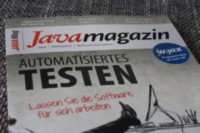
Wordpress bugs me. It slows down the authoring process and comes with security issues and maintenance efforts. That’s why I moved to Hugo. Hugo is a static website generator and allows me to write effectively and offline. In this post, I show my reasons for moving from Wordpress to Hugo and point out tips and tricks for the migration.

Today I delivered a guest lecture at the Chemnitz University of Technology at the chair of Distributed and Self-organizing Systems. The lecture revolved around microservices in practice at Spreadshirt.

Coding with Kotlin is great fun. But things are getting really interesting when we try to use Kotlin in conjunction with popular frameworks like Spring Boot and Vaadin. The development with those frameworks can benefit a lot from Kotlin. However, we have to pay attention to some pitfalls.

We at Spreadshirt have started to use the JVM language Kotlin in a couple of services. This ended up in great enthusiasm. Kotlin allows us to significantly reduce the boilerplate and to write more robust and readable code. In fact, I don’t want to write Java anymore. In this post I like to show you why.

I’ve worked with Eclipse for 7 years. Now I switched to IntelliJ IDEA and I’m extremely happy with this IDE. To my mind IntelliJ IDEA is definitely superior to Eclipse. In this post I show you why.

A typical Jenkins 1.0 setup for Continuous Integration (CI) comes with some drawbacks. The job configuration is stored somewhere else but not in the version control system. This makes it hard to set up a new job correctly or to track configuration changes. Another pain point are the various tools (JDK, Maven, node, gulp etc.) that have to be installed and maintained on all Jenkins nodes. This increases the maintenance effort and can slow down the development. Let’s consider some solutions for these issues.

The latest issue 11.2016 of the “Java Magazin” has been published. It contains my article about the testing of RESTful services. If you don’t speak German, don’t panic. The article is more or less a translation of my blog post “Testing RESTful Services in Java: Best Practices”.

Developing with Python was a refreshing and pleasant experience. After working with Java for a while, you may forget how verbose and clumsy this language is sometimes. But Python shows how simple and powerful a programming language can be. Let me show you some examples.

Auto increment IDs are not working well when it comes to distributed databases. Instead, we should use UUIDs. Let’s consider the pros and cons of UUIDs and how we can use them with Hibernate and MySQL.

Dealing with version numbers is an important challenge on the way to Continuous Delivery. The classical versioning approach (“8.2.0”) and release workflow is inappropriate, because it can’t be automated properly. This post shows how we can leverage the Git commit hash to get rid of manual workflows and automate the Continuous Delivery pipeline. At the end, every build will produce an artifact which is potentially shippable. We’ll implement this solution with Maven and Docker.








